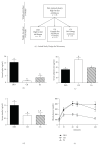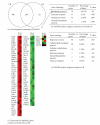Differential effects of calorie restriction and exercise on the adipose transcriptome in diet-induced obese mice
- PMID: 21603264
- PMCID: PMC3092555
- DOI: 10.1155/2011/265417
Differential effects of calorie restriction and exercise on the adipose transcriptome in diet-induced obese mice
Abstract
We tested the hypothesis that obesity reversal by calorie restriction (CR) versus treadmill exercise (EX) differentially modulates adipose gene expression using 48 female C57BL/6 mice administered a diet-induced obesity (DIO) regimen for 8 weeks, then randomized to receive for 8 weeks either: (1) a control (AIN-76A) diet, fed ad libitum (DIO control); (2) a 30% CR regimen; (3) a treadmill EX regimen (with AIN-76A diet fed ad libitum); or (4) continuation of the DIO diet. Relative to the DIO controls, both CR and EX reduced adiposity by 35-40% and serum leptin levels by 80%, but only CR increased adiponectin and insulin sensitivity. Gene expression microarray analysis of visceral white adipose tissue revealed 209 genes responsive to both CR and EX, relative to the DIO group. However, CR uniquely altered expression of an additional 496 genes, whereas only 20 were uniquely affected by EX. Of the genes distinctly responsive to CR, 17 related to carbohydrate metabolism and glucose transport, including glucose transporter (GLUT) 4. Chromatin immunoprecipitation assays of the Glut4 promoter revealed that, relative to the DIO controls, CR significantly increased histone 4 acetylation, suggesting epigenetic regulation may underlie some of the differential effects of CR versus EX on the adipose transcriptome.
Figures





References
-
- Flegal KM, Carroll MD, Ogden CL, Curtin LR. Prevalence and trends in obesity among US adults, 1999–2008. Journal of the American Medical Association. 2010;303(3):235–241. - PubMed
-
- Meisinger C, Döring A, Thorand B, Heier M, Löwel H. Body fat distribution and risk of type 2 diabetes in the general population: are there differences between men and women? The MONICA/KORA Augsburg Cohort Study. American Journal of Clinical Nutrition. 2006;84(3):483–489. - PubMed
-
- Calle EE, Rodriguez C, Walker-Thurmond K, Thun MJ. Overweight, obesity, and mortality from cancer in a prospectively studied cohort of U.S. Adults. New England Journal of Medicine. 2003;348(17):1625–1638. - PubMed
-
- Watson RT, Pessin JE. GLUT4 translocation: the last 200 nanometers. Cellular Signalling. 2007;19(11):2209–2217. - PubMed
Grants and funding
LinkOut - more resources
Full Text Sources

